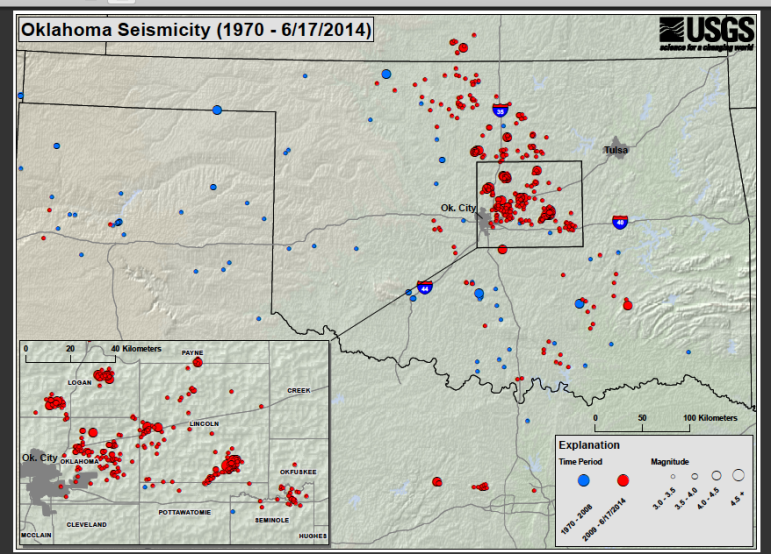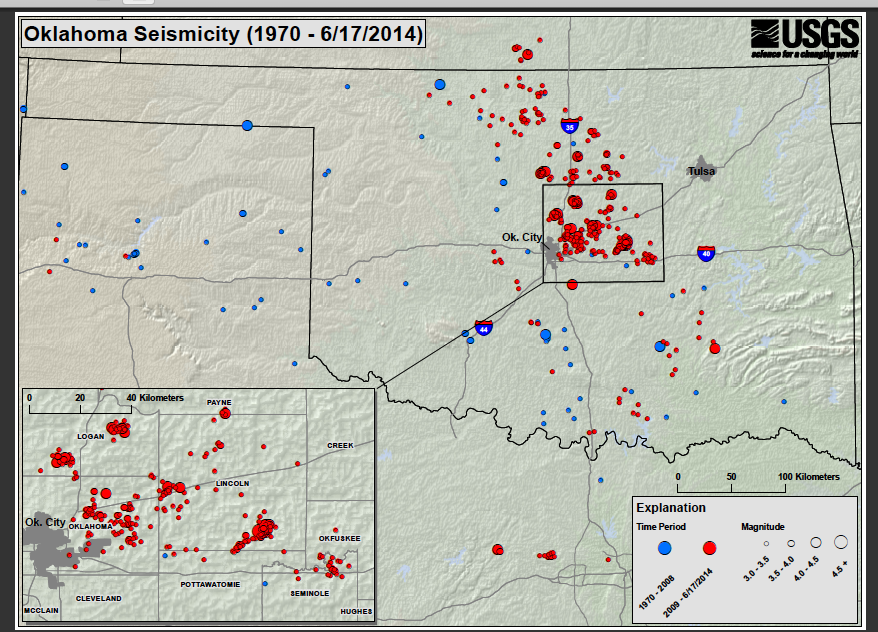
Oklahoma Seismicity (1970 – 6/17/2014): U.S. Geological Survey
Two minor earthquakes shook Oklahoma early this morning.
Seven hit the state yesterday.
These nine events bring the week’s total to sixteen earthquakes, including a 4.3 magnitude on Monday near Medford.
And this number is just par for the course. In the last 30 days, the USGS has recorded 81 earthquakes of at least 2.5 magnitude in Oklahoma, including another 4.3 magnitude quake July 12 near Langston.
The rate of earthquakes in Oklahoma has increased by about 50 percent since October 2013, according to a joint statement by the U.S. Geological Survey and Oklahoma Geological Survey. In the statement the agencies reported that 183 earthquakes of magnitude 3.0 or greater occurred in Oklahoma from October 2013 through April 14, 2014. This compares with a long-term average from 1978 to 2008 of only two magnitude 3.0 or larger earthquakes per year. Looking at figure 1 above, the red dots (earthquakes from 2009 to June 2014) vastly outnumber the blue dots (earthquakes from 1970 to 2008) and the red dots are growing faster than bacteria on moldy bread.
Are the Earthquakes Related to Oil and Gas Drilling?
Several scientists believe that fracking disposal wells could be causing the recent spate of earthquakes in Oklahoma. According to the state’s Corporate Commission data more than 10,000 underground injection wells were active in Oklahoma as of January 2013. Of these, 4400 are disposal wells used to store drilling waste between 10,000 and 20,000 feet underground.
In 2012, the U.S. Geological Survey released a report that found most of the recent earthquakes have taken place near active injection wells. The scientists who conducted the study said it is possible that the high water pressure used in wastewater injections could push previously “locked” faults loose, causing an earthquake. The report determined that the quakes are “almost certainly manmade.”
Scientists at Columbia University who studied a rare 4.0 earthquake that took place in Ohio in 2011 confirmed that waste disposal wells could be causing the earthquakes.
Earlier this month a study published in Science also suggested that wastewater injection could be responsible for the quakes. Lead author Katie Keranen, a geophysics professor and research seismologist at Cornell University, focused her research on four southeast Oklahoma City wells that inject more water than other disposal wells. Quoted in an story by StateImpact, Keranen said she believes that this high volume of water may lie behind the quakes.
These extremely high rates can cause a very large area to be stimulated or perturbed in the subsurface.
Keranen and her team wanted to understand where the injection water flows and where it ends up. To investigate this phenomenon they fed earthquake and disposal well locations, times, pressure data, and wastewater volume measurements into a three-dimensional model of the rock layers, faults and water formations underground. Their model showed that fluid spreads out over a large area and builds up pressure underground. As the pressure builds it can cause fault lines to slip and trigger earthquakes.
How can the science direct policy?
Keranen’s model can’t place the blame on any specific well and scientists say they will likely never have the data they need to prove that kind of cause and effect. This implies that the only course of action to prevent fracking would be a statewide ban on fracking disposal wells. But even this wouldn’t have the desired affect, Keranen said in the StateImpact story.
It would take likely years for this fluid pressure that’s already there to diffuse away, and so you’d see earthquakes continuing.
The National Research Council‘s list of best practices for drillers and disposal well operators includes investigating any potential disposal site’s history of earthquakes and its proximity to fault lines. Some states do such investigations and forbid any deep injection wells near fault lines—Oklahoma is not one of these states.
Cliff Frolich, the Associate Director of the University of Texas Institute for Geophysics, believes in taking the above approach and also that companies should look for new ways to dispose of well water. Alternative disposal tactics are costly, however, and companies will only use them if states require it.
Matt Skinner, a spokesman for the Oklahoma Corporation Commission, which regulates oil and gas activity in the Oklahoma, believes that the new research findings are ‘significant’ according to the StateImpact story.
This is a very important piece that needs to be carefully reviewed.
The OCC has already adopted stricter monitoring rules for disposal wells, clamped down on some operators, and has eliminated some permit shortcuts in quake-prone regions. The commission also has a document on the front page of its website entitled OCC continues to work on issue of induced seismicity.
Skinner believes that if Keranen’s research proves correct, the oil and gas industry’s link to the earthquakes could actually be easier to manage, because regulators could focus on only writing rules for the small number of high-volume wells that may be causing the most shaking.
But if earthquakes might be causing Oklahomans to shake, any impacts to the oil and gas industry might make them shudder even more. Talking to NPR’s Linda Wertheimer in an interview this morning, Joe Wertz of StateImpact Oklahoma, discussed how a lot of people who are impacted by the earthquakes also work in the oil and gas industry.
So we’re put in a precarious situation between this phenomenon that’s happening and an industry that we’d like to preserve and promote.








